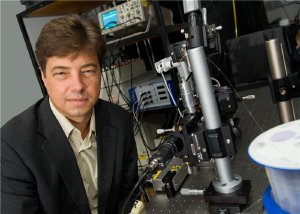Sep 1 2009
Computers which use light to process large amounts of data faster than ever before are just one of many groundbreaking potential applications of a new £6 million research programme at Queen's University Belfast and Imperial College London, launched today, 1 September 2009.
 Prof Anatoly Zayats from Queen's University Belfast's Centre for Nanostructured Media
Prof Anatoly Zayats from Queen's University Belfast's Centre for Nanostructured Media
The Engineering and Physical Sciences Research Council (EPSRC) is funding the two universities to establish a world-leading research programme on the fundamental science of so-called ‘nanoplasmonic devices'.
Nanoplasmonic devices' key components are tiny nanoscale metal structures - more then 100 times smaller than the width of a human hair – that guide and direct light.
The structures have been tailor-made to interact with light in an unusual and highly controlled way. This means they could one day be used to build new kinds of super-high-speed ‘optical computers' – so named because they would process information using light signals, instead of the electric currents used by today's computers.
At present, the speed with which computers process information is limited by the time it takes for the information to be transferred between electronic components. Currently this information is transferred using nanoscale metallic wires that transmit the signals as an electric current.
To speed up the process, the scientists at Queen's and Imperial hope to develop a way of sending the signals along the same wires in the form of light.
In order to achieve this, they are developing a raft of new metallic devices including tiny nanoscale sources of light, nanoscale ‘waveguides' to guide light along a desired route, and nanoscale detectors to pick up the light signals.
Similar approaches may also help in the development of devices for faster internet services.
Professor Anatoly Zayats from the Queen's University's Centre for Nanostructured Media who leads the project said: “This is basic research into how light interacts with matter on the nanoscale. But we will work together with and listen to our industrial partners to direct research in the direction that hopefully will lead to new improved products and services that everyone can buy from the shelf.”
Professor Stefan Maier, who leads the research team at Imperial added: “This is an exciting step towards developing computers that use light waves, not electrical current, to handle data and process information. In the future these optical computers will provide us with more processing power and higher speed. This will also open the door to a world of possibilities in scientific fields at the interface with the biosciences, and perhaps even in the world of personal computing.”
The project is also supported by INTEL, Seagate, Ericsson, Oxonica, IMEC and the National Physics Laboratory.